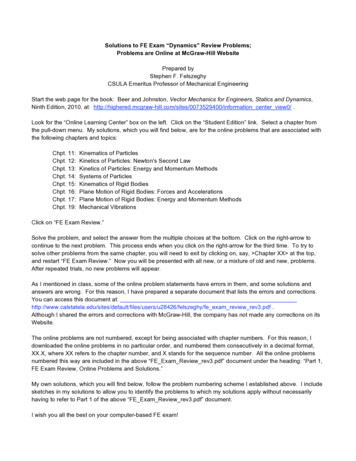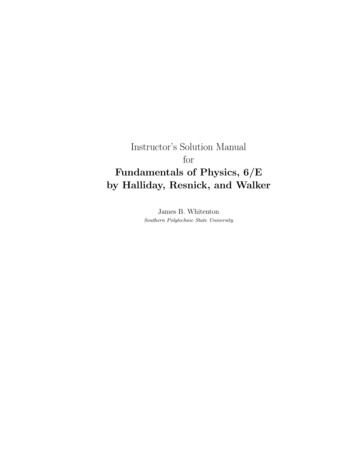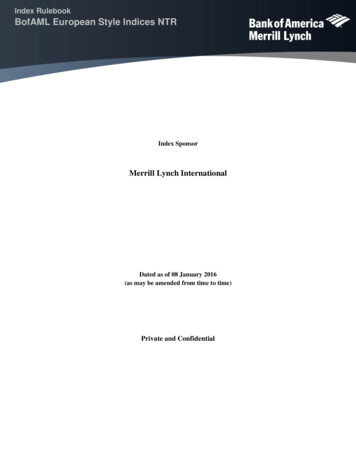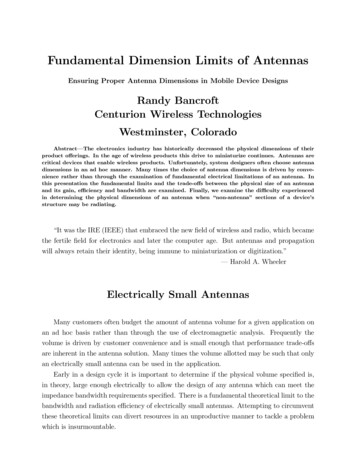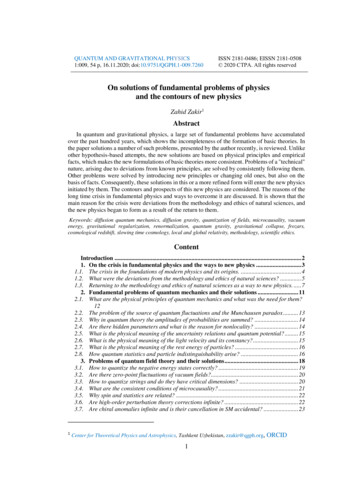
Transcription
QUANTUM AND GRAVITATIONAL PHYSICS1:009, 54 p, 16.11.2020; doi:10.9751/QGPH.1-009.7260ISSN 2181-0486; EISSN 2181-0508 2020 CTPA. All rights reservedOn solutions of fundamental problems of physicsand the contours of new physicsZahid Zakir1AbstractIn quantum and gravitational physics, a large set of fundamental problems have accumulatedover the past hundred years, which shows the incompleteness of the formation of basic theories. Inthe paper solutions a number of such problems, presented by the author recently, is reviewed. Unlikeother hypothesis-based attempts, the new solutions are based on physical principles and empiricalfacts, which makes the new formulations of basic theories more consistent. Problems of a "technical"nature, arising due to deviations from known principles, are solved by consistently following them.Other problems were solved by introducing new principles or changing old ones, but also on thebasis of facts. Consequently, these solutions in this or a more refined form will enter the new physicsinitiated by them. The contours and prospects of this new physics are considered. The reasons of thelong time crisis in fundamental physics and ways to overcome it are discussed. It is shown that themain reason for the crisis were deviations from the methodology and ethics of natural sciences, andthe new physics began to form as a result of the return to them.Keywords: diffusion quantum mechanics, diffusion gravity, quantization of fields, microcausality, vacuumenergy, gravitational regularization, renormalization, quantum gravity, gravitational collapse, frozars,cosmological redshift, slowing time cosmology, local and global relativity, methodology, scientific ethics.ContentIntroduction . 21. On the crisis in fundamental physics and the ways to new physics . 31.1. The crisis in the foundations of modern physics and its origins. . 41.2. What were the deviations from the methodology and ethics of natural sciences? . 51.3. Returning to the methodology and ethics of natural sciences as a way to new physics. . 72. Fundamental problems of quantum mechanics and their solutions . 112.1. What are the physical principles of quantum mechanics and what was the need for them?122.2. The problem of the source of quantum fluctuations and the Munchausen paradox . 132.3. Why in quantum theory the amplitudes of probabilities are summed? . 142.4. Are there hidden parameters and what is the reason for nonlocality? . 142.5. What is the physical meaning of the uncertainty relations and quantum potential? . 152.6. What is the physical meaning of the light velocity and its constancy? . 152.7. What is the physical meaning of the rest energy of particles? . 162.8. How quantum statistics and particle indistinguishability arise? . 163. Problems of quantum field theory and their solutions . 183.1. How to quantize the negative energy states correctly? . 193.2. Are there zero-point fluctuations of vacuum fields?. 203.3. How to quantize strings and do they have critical dimensions? . 203.4. What are the consistent conditions of microcausality? . 213.5. Why spin and statistics are related? . 223.6. Are high-order perturbation theory corrections infinite? . 223.7. Are chiral anomalies infinite and is their cancellation in SM accidental? . 231Center for Theoretical Physics and Astrophysics, Tashkent Uzbekistan, zzakir@qgph.org,1ORCID
Zakir, Z. (2020) Quantum and Gravitational Physics 1:7260-00923.8.3.9.3.10.4.4.1.4.2.Is quantum gravity consistent? . 24How to describe the possible substructure of fundamental particles? . 24Is there a need for supersymmetry? .25Problems of gravitational collapse and their solutions.26How to describe structure and evolution of an extended object in GR?. 26Can the surface of a collapsing star cross its gravitational radius and fall to the center?274.3. How does the shell collapse and will it have a horizon and a singularity? . 284.4. How a dust star collapses and how its structure evolves? .294.5. How does a rotating star collapse and will it have an ergosphere? .314.6. When a relativistic explosion of a collapsing star can occur? .324.7. Do collapsed stars have a "hairstyle"? .334.8. Can two collapsed stars merge? . 344.9. How supermassive collapsars differ from ordinary ones? .354.10. Is there a quantum evaporation of collapsed stars? . 355. Problems of the theory of gravity and their solutions .365.1. Was Maxwell right about the nature of gravity? . 365.2. What underlies the principle of equivalence? .375.3. What is the physical mechanism of gravity?.385.4. What is the physical meaning of Einstein's equations? . 396. Problems of cosmology and their solutions .396.1. The double redshift paradox in relativistic cosmology . 406.2. Is it necessary to take into account aberration in cosmology? .416.3. Does the rate of proper times change during expansion? .416.4. Are there cosmological constant and dark energy? . 426.5. Problems of Friedmann models of cosmology and their solutions .436.6. Does dark matter exist? .436.7. What are the curvature and global structure of the universe? .447. From SR and GR to local and global theories of relativity .447.1. LR is a local form of SR and for this reason it is universal. .457.2. GlR as a physical part of GR on hypersurfaces of simultaneity. .467.3. Consequences of LR and GlR for quantum and gravitational physics . 488. The contours and perspectives of new physics . 498.1. The contours of new physics. . 498.2. Scientific perspectives of new physics. .518.3. Social perspectives of new physics. .52Conclusion . 53References . 53IntroductionRelativity theory and quantum theory, together with their applications to particle physics,astrophysics, and cosmology, form the theoretical foundation of modern physics. They describemost of the known facts, predicted many new ones and have been repeatedly confirmed.Nevertheless, many fundamental unsolved problems remained in the foundations of these basictheories and in their important applications. Moreover, due to ambiguities in the definition ofbasic concepts and physical principles, they still could not become consistent physical theories,i.e. besides particular problems, there was also a common problem - their incompleteness.The list of unsolved problems in physics is wide enough and is often given in theliterature. But only some of them are fundamental, i.e. relate to the principles of physics or theirmost important consequences. Moreover, many unsolved problems were classified as“resolved” only because of the existing consensus on the “correctness” of one of the hypotheses.The solution to at least some of these fundamental problems will remarkably change thephysical picture of the world [30,35].
On solutions of fundamental problems of physics and contours of new physics3The present paper provides an overview of those fundamental problems for which theauthor has proposed new solutions presented in recent papers in 2020 [39-44] and which aresystematically presented in the books [45-49] (earlier publications of the author contained onlytrial versions). Unlike other authors, who proceeded from hypotheses without an experimentalbasis, the developed approach proceeds from physical principles and facts. This way of solvingproblems of physics, as the history shows, is the most reliable and its results are trustworthy. Itis usually quite productive too, since giving explanations for previously inexplicablephenomena, it also leads to unexpected predictions.The easiest to understand are solutions to fundamental problems of a "technical" nature,i.e. problems arising due to inadequate application of the principles of basic theories ordeviations from them. They are solved by consistently following these principles, correctingdistortions and errors in the old paradigm that arose because of these problems. These solutionsthus complete the formation of basic theories, which were delayed due to these deviations.More radical are solutions related by the introduction of new or change in knownprinciples. But even in these cases, they are not hypotheses, but the conclusions from knownfacts. In physics as natural science, any change in paradigm associated with the formulation ofnew or clarification of known principles opens up new perspectives and, therefore, begins anew stage of development.In the Part 1 of the paper the reasons for the almost half-century crisis in the foundationsof physics and the ways to overcome it are discussed. It is shown that the main cause of thecrisis was a departure from the methodology and ethics of natural sciences, and the new physicsis the result of a return to them.Solutions to particular problems are grouped into six parts (Parts 2-7), each of which isindependent, although the results of all parts are mutually consistent. Therefore, each of theparts can be read independently, starting with those that are more interesting to the reader. Inthe last part (Part 8), the contours and perspectives of the new physics, following from theproposed solutions to the problems, are considered.List of abbreviations: SR - special relativity, GR - general relativity, QFT - quantum field theory,SF - Stueckelberg-Feynman, SM - Standard Model, DQM - diffusion quantum mechanics, STC- slowing time cosmology, FR - frame of reference, LFR - local FR, GFR - global FR, LR – localrelativity, GlR - global relativity.1. On the crisis in fundamental physics and the ways to new physicsIn the last almost half a century, after the triumphant discovery of neutron stars in thelate 60s, and then the completion of SM of particle physics in the mid-70s, fundamental physicswas in a deep crisis. Everything that was discovered at that time in experiments was predictedbefore 1975 in the framework of GR, QM, QFT, and SM. However, a number of fundamentalproblems remained unresolved both in these theories and in the description of phenomenabeyond them. But the theoretical models created to solve these problems have not beenconfirmed, and moreover, they created more problems than solved [30]. The reasons for thislong time crisis and ways to overcome it are discussed below.1. The crisis in the foundations of modern physics and its origins.2. What were the deviations from the methodology and ethics of natural sciences?3. The way to new physics is in a return to the methodology and ethics of naturalsciences.The problems of the methodology of physics will be discussed in more detail in the book [49].
4Zakir, Z. (2020) Quantum and Gravitational Physics 1:7260-0091.1. The crisis in the foundations of modern physics and its origins.The set of fundamental problems of physics, which will be considered in this paper, arosemainly in the first half of the 20th century and took its final form in the 1970s, and since thenthis set has remained practically unchanged. It became an organic part of the current paradigm,expressing its internal contradictions, as well as contradictions with a number of known facts.As the reasons for such a long stagnation, in fact, a crisis, the lack of experimental factsnecessary for further progress and the impossibility of testing the leading hypotheses in theforeseeable future were indicated [30,35]. However, this paper shows the opposite, that suchfacts were enough for normal development and thus this does not explain such long crisis.If the crisis was not inevitable, then it could have occurred due to a lack of resources human and otherwise - compared to the scale of the tasks, as well as external reasonsunfavorable for the scientific community. But, by the irony of history, in the last half century,fundamental physics had more resources, human and otherwise, and external conditionsfavorable for development than in its entire history before that. Therefore, everything happenedjust the opposite, and the longest crisis in the history of physics occurred precisely when therewere all the conditions for rapid development.How could such a crisis occur in fundamental physics in the absence of internal andexternal objective reasons? Naturally, only due to subjective reasons, crisis processes within thescientific community itself.The first of these reasons for the crisis, as will be shown in the next Section, was adeviation from the methodology of natural sciences in solving fundamental problems of physicsand the promoting the resulting untenable paradigm changes by extra-scientific methods. Thisled, firstly, to the inclusion into the paradigm in some cases of two incompatible explanationsof a physical phenomenon as compatible ones, and, secondly, to the replacement of the analysisof facts with mathematical hypotheses with non-physical entities contradicting to these facts.All this divided the scientific community into two incompatible parts - supporters andopponents of such distortions of scientific methodology. At the same time, each of these partsof the community began to degrade - the first because of the achieved de jure monopoly ontruth, the second because of being pushed aside to the position of dissidents only because of thefidelity of scientific methodology, and this became the catalyst for a systemic crisis.The first reason led to two more other reasons that deepened the crisis, turning a purelyscientific crisis into a crisis of the entire scientific community. These reasons were systematicdistortions of scientific ethics and science policy. Naturally, the departure from the methodologyof natural sciences led to objections and alternatives. But the majority of the scientificcommunity, united around the standard paradigm and leading hypotheses, in the absence oflogical answers to opponents, not only began to ignore criticism, but also to supersede thesupporters of reasonable alternatives from the scientific literature and the scientific community.A distortion of scientific ethics and science policy was also the imposition of unconvinceddoctrines on the scientific community, the education system and the general public by methodsof large-scale propaganda. As a result, both the scientific community and the organization ofscience as a whole get on the way of conservation of the standard paradigm and leading searchdirections, which led to stagnation instead of development. Notice, without delving into theproblems of the scientific community, that a society, supporting fundamental science as one ofthe basic values of civilization, was not ready for such a situation and did not have mechanismsto assist fundamental science to overcome such a long time systemic crisis.The uniqueness of this crisis lies in the fact that if before that every epoch in the historyof physics gave confirmed solutions to a large number of fundamental problems, then after sucha "putsch" in the methodology and organization of science, fundamental physics turned out tobe practically fruitless, and reached a dead end. The huge resources of society, both human andotherwise, turned out to be directed mainly towards illusory goals, towards “fight windmills”,which is ordinary for mathematical-minded people, but unnatural for physicists.
On solutions of fundamental problems of physics and contours of new physics51.2. What were the deviations from the methodology and ethics ofnatural sciences?Deviations from the methodology of natural sciences, as involuntary and temporaryones, were already admitted in basic theories, in quantum mechanics, QFT and GR, and duringthe crisis they, instead of liquidation, were brought to the point of absurdity. These deviationsconsisted in reconciling with contradictions, practicing so-called doublethink, instead ofactually resolving them, as well as inflating the non-physical parts of basic theories bydescribing illusory worlds, instead of being limited to their physical parts and describing reality.A. Doublethink.In a number of cases, two opposite explanations of the same physical phenomenon wereaccepted as equally admissible. This is known in psychology as the phenomenon of"doublethink", the ability of people to hold two opposite beliefs at the same time. Atdoublethink, the phenomenon in one case is explained by the desired unreal reason, withouttaking into account the real reason, and then, when it is necessary to explain also through thereal reason, the unreal one is not taken into account. As a result, a false belief is created thatunreal and real reasons are equally acceptable.Doublethink is characteristic for communities where like-mindedness is established notonly in what is true, but also in what has not been proven to be true, but it is beneficial to thedominating part of the community. In a scientific community, where the supporters ofdoublethink dominate, instead of using scientific methodology to resolve contradictions,reconciliation with them is required, and like-mindedness and agreement on this issue becomethe conditions for belonging to the dominant part or to the scientific community in general.In Section 1.3 the cases of doublethink in quantum and gravitational physics arepresented. In quantum physics these are the cases of the wave-particle duality, Munchausen'sparadox, the zero-point vacuum fluctuations and strong microcausality. In gravitational physics,these are the treatments of gravitational redshift, gravitational time dilation, gravitationalcollapse, redshift and aberration in cosmology. In each of these cases, it is also shown how areturn to the methodology of natural sciences excludes previous doublethink.In particular, wave-particle duality consists in the fact that in an ensemble of experimentscarried out each time with one electron, this ensemble demonstrates wave properties, but whenthe wave properties were attributed to each electron, it was doublethink. Based on this, absurdstatements were made that an electron is capable of simultaneously passing through two, threeand hundreds slits on a screen in its way, and then on the second screen to interfere with itself.The initial assumption that fluctuating microparticles are isolated and capable of spontaneouslychanging their energy and momentum led to this absurdity. As will be shown in the paper, whenthe question about the source of fluctuations of microparticles is raised from the very beginningand the correct answer is given, then the rest of the questions are solved without any absurdity.Another example of doublethink is the zero-point fluctuations in the vacuum of quantumfields. The well-known effects, the Lamb shift and the Casimir effect, are completely explainedby the electromagnetic fields of real sources. But, if one can switch off (!) these real sourcesand assumes the existence of the zero-point vacuum fluctuations, then these two effects canalso be fully explained. On this basis, in the standard paradigm, it was accepted to consider thereality of the zero-point vacuum fluctuations as “proven”. However, the question of howexperimenters could in the real world "turn off" the influence of the real sources was notspecified in any way, which is typical for other cases of doublethink also.Doublethink in the case of the zero-point fluctuation has led, in particular, to stringmodels. All the “business” in these models was based on the hypothesis about the zero-pointfluctuations. Since this led to some anomalies, then to eliminate them, the dimension of spacehad to be equal to the critical one, which fixed the symmetries and properties of particles andfields. But, as it turned out, fields and strings can and should be quantized without zero-pointfluctuations, which makes string models trivial due to the lack of critical dimensions.
6Zakir, Z. (2020) Quantum and Gravitational Physics 1:7260-009These and other examples of doublethink are discussed in Section 1.3, and they are allbased on the same departure from the methodology of natural sciences, while a return to it andthe search for real solutions to problems excludes doublethink.B. Plunging into the non-physical parts of basic theories and fictitious worldsThe basic theories, on the one hand, contained a physical part, on which all theirsuccesses and authority were based, and on the other hand, their historical formulations alsoincluded a non-physical part, introduced by the founders temporarily in the hope that newgenerations would be able to exclude it from theory.However, instead of this step required by the methodology of natural sciences, nextgenerations of researchers began to do exactly the opposite. Instead of limiting the physicalparts of basic theories, they began to develop their non-physical parts. The non-physical partswere considered legalized due to they were in the basic theories and it was ignored the fact thatthey, unlike the physical parts, are not confirmed.An example is the above mentioned situation in quantum theory. In radioactive decay, itwas assumed that a particle supposedly leaves the potential well without external help. Here,the choice of the particle itself as the source of the energy it needs for such an exit meansattributing to it the “Munchausen’s” ability to pull itself out of the swamp (see Section 1.3 aboutthe “Munchausen paradox”). In quantum mechanics, free particles were considered as isolatedones, as in classical mechanics, but with "quantum" properties, i.e. able to accidentally changeown energy and momentum. But it violated one of the basic laws of physics for an isolatedobject - the energy and momentum conservation in a homogeneous and isotropic space.Even stranger and unacceptable from the point of view of the methodology of naturalsciences was the ignoring in the standard formulation of QFT the effects of gravity in loopdiagrams, where the physical energy of quanta in intermediate states can be very large. Basedon this temporarily introduced simplification that becomes illegal around the Planck energies,it was further concluded that the contributions of such diagrams to the characteristics ofparticles (masses, charges, process probabilities) are "infinite." To eliminate these fictitious“infinities”, large-scale research programs were then developed over many decades.And, finally, the formalism of GR allowed the introduction of arbitrary frames ofreference, although, according to the equivalence principle, only those related by local Lorentztransformations were locally admissible, and all the others were nonphysical. In GR, acosmological constant of any sign was also allowed. On the formal "admissibility" of thenonphysical frames of reference in GR, the hypotheses about black holes and unremovable"infinities" in quantum gravity are based. On such “admissibility” of antigravity with a constantenergy density in the expanding space is based the SM in cosmology.The most dramatic was the departure from the methodology of natural sciences in thetheory of stellar collapse. This theory reached its highest point in the 1939 Oppenheimer-Snyderpaper [23], where a set of simultaneously occurring events along the world lines of particlesinside a homogeneous dust star was found. It was the physical solution to the collapse problemwith the correct taking into account the initial and boundary conditions, and according to it thecollapsing star quickly freezes on the hypersurfaces of simultaneity. However, the scientificcommunity did not understand the Oppenheimer-Snyder solution and follow a false scent ofignoring it. This ignoring was done by replacing it with the local Friedman solution, whichcoincides with the Newtonian one (presenting Friedman's solution as the "Oppenheimer-Snydersolution"). The result was the Newtonian theory scenario of the collapse with the formation of"black holes". The crossing of gravitational radius by the stellar surface, which is declared bythis scenario, in GR cannot occur in a finite time of the external world and therefore is anonphysical "event". The true Oppenheimer-Snyder solution, describing physical events duringthe collapse of entire star, was restored in the frozar theory (see Part 4).In this regard, it should be recalled that the methodology of mathematical physics, whosepriority was one of the main reasons for the crisis, is principally different from the methodologyof theoretical physics. In theoretical physics, a mathematical model is true only when it
On solutions of fundamental problems of physics and contours of new physics7describes reality and this is confirmed experimentally. In mathematical physics, however, thestudy of models of worlds more interesting and diverse than the real world is a normal scientificactivity, and the concept of truth is narrowed down to the level of internal consistency of amathematical model. The richness and beauty of these worlds often lured physicists, while themission of the latter is to study only our reality as it is. Many founders of physics fell into thistrap of mathematical power and beauty, but before this did not lead to such a long dominancein the current paradigm of fundamental physics of the fictitious worlds of mathematical physics.During the crisis, these deviations from the methodology of natural sciences became thenorm and they were legalized for new hypotheses also. Moreover, the latter purposefullyreinforced and systematically developed precisely these deviations. At the same time, theelimination of the physical restrictions in the construction of worlds more interesting thanreality became the strongest doping and the scientific community plunged into these wonderfulworlds for a long time and practically forgetting real physics.Thus, reconciliation with doublethink and legitimization of the non-physical parts of thebasic theories of physics by appealing to their experimentally tested physical parts, as well asthe unreasonable mathematization of theoretical physics, led to a departure from themethodology of natural sciences, and further steps on this doubtful, and often simply wrongway were predestined to failure initially. As a result, practically none of the fundamentalproblems of physics was solved, even those of them for the solution of which there were alreadyall the conditions. A return to the methodology of natural sciences, as will be shown below,allows one to find reasonable solutions for most of these problems without new hypotheses andopens the way to new physics.1.3. Returning to the methodology and ethics of natural sciences as away to new physics.The methodology of physics as a natural science is based on the accumulation andanalysis of experimental facts and their explanation by putting forward hypotheses andconstructing theories on their basis. Fundamental physical theory proceeds from physicalprinciples based on experiments and allows one to describe and explain by deduction all otherfacts in the field of its applicability.A hypothesis contains at least one initial assumption, or a mathematical axiom, whichdoes not directly follow from experiments. If one of these hypotheses describes most of thefacts, or even all known, then it becomes a candidate for a working theory. If the predictions ofthe hypothesis are confirmed, i.e. it allows one to discover new facts, then it beco
1. On the crisis in fundamental physics and the ways to new physics In the last almost half a century, after the triumphant discovery of neutron stars in the late 60s, and then the completion of SM of particle physics in the mid-70s, fundamental physics was in a deep crisis. Everything that was discovered at that time in experiments was predicted




